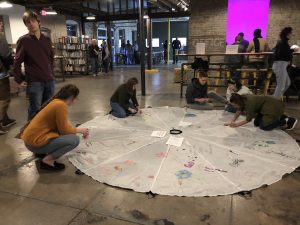19 Activity 5.1 – Heritage Activism: Design a Project
Elizabeth Kryder-Reid

Associated Readings:
Ch 16: Ana Isabel Baptista, “Environmental Justice Tours: Transformative Narratives of Struggle, Solidarity, and Activism.”
Visual Essay 3: Gabriel Filippelli, “Getting the Lead Out, One Community at a Time.”
Visual Essay 4: Cornelius Holtorf, “Taking Care of Nuclear Waste.”
Possible additional readings:
Additional readings in section 5.
Beverly Serrell, “Behind it All: A Big Idea.” In Exhibit Labels: An Interpretive Approach. Walnut Creek: Alta Mira Press, 1996.
Targeted Skills:
Communication, Creativity, Research
Directions:
The readings in Section 5 share different strategies for engaging public audiences with the issues of toxic heritage including tours (Baptista), citizen science (Filippelli), exhibits (Holtorf), programs (McKenzie, Valderrama), art (Joyce), maps (Valderrama), reparations (Sevcenko). Who are the target audiences of these interventions? What do these different strategies seek to do — i.e. what changes in knowledge, behaviors, attitudes, and status do they try to create?
With those audiences and intended outcomes in mind, select a toxic site in your community and develop a toxic heritage project.
- Identify a target audience for your project. You may need to do some research to understand who are the stakeholders of this site and its associated issues. For example, who is affected by the toxicity (eg. People living in proximity? People living downwind or downstream? Workers? Families of workers?). Who are the people working as advocates and activists about the site? Who are the responsible parties for the contamination or other toxicity? Who are involved in the regulation, remediation, and policy creation relevant to the site?
- What is your desired outcome? What difference do you want to make in the lives of the people who participate in your project?
- Select a strategy to engage your target audience in the history and issues of the site and to produce the outcome you’ve identified. For example, you might develop a physical or digital exhibit, oral history collection, art installation, tour, StoryMap, data collection, interpretive program.
- Develop a concept proposal for your project. You may find this Toxic Heritage Project Concept Template useful, or you may want to adapt it for the specific project you are imagining.

